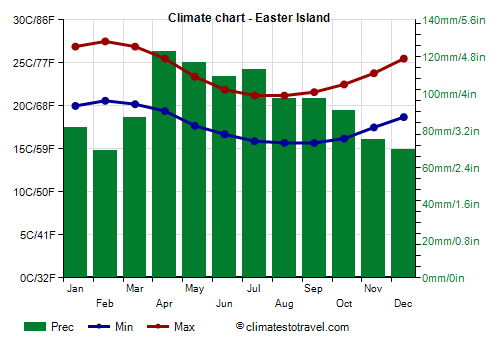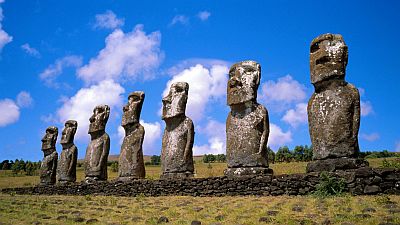Select units of measurement for the temperature and rainfall tables (metric or imperial).
Average weather, temperature, rainfall, sunshine
The climate of Easter Island (Rapa Nui) is
subtropical, warm and humid in summer and mild in winter, in fact, the average daily temperature ranges from 23/24 °C (74/75 °F) in the period from January to March to 18.5/19 °C (65/66 °F) in the period from July to September. The island is situated in the Southern Hemisphere, where the seasons are reversed in comparison with those in Europe or North America.
The
wind blows frequently throughout the year.
The island is located outside the area in which tropical cyclones form.
Easter Island is located 3,600 kilometers (2,200 miles) west of Chile, lost in the Pacific Ocean, a little to the south of the Tropic of Capricorn, and it's famous for the large stone statues called
moai, which are a sort of watchmen of the island. In the interior of the island, we find three extinct volcanoes, not very high, the highest of which is
Ma'unga Terevaka, 507 meters (1,664 feet) high.
The climate in detail
Climate data

Since the island is located in the ocean and at a great distance from the continents, the daily
temperature range is reduced. Although the maximum temperatures are usually not too high, and are around 27 °C (81 °F) in the warmest period that goes from January to March, they can sometimes reach 28/30 °C (82/86 °F) from November to March, while in winter, from June to September, they reach a maximum of 25/26 °C (77/79 °F). In the latter period, sometimes at night it can get a bit cold, in fact the temperature can sometimes drop down to 7/9 °C (45/48 °F).
The
rainfall on Easter Island is quite abundant, around 1,050 millimeters (42 inches) per year, and it's evenly spread over the seasons, though it's more abundant in April and May. Sometimes, periods of bad weather with heavy rains may occur during the winter, from June to August.
The amount of
sunshine is not so good from April to September, while it is good in summer, from December to March. On average, there are around 2,500 hours of sunshine per year.

The
sea is warm enough for swimming from January to April, when it reaches 24/25 °C (75/77 °F), while it is a little cold, around 20 °C (68 °F), from July to October.
When to go
Notwithstanding the fact that you can go to Easter Island all year round because it has a good climate, the best time is the austral summer, from
December to March, since it is the warmest and sunniest period of the year. The heat is usually bearable, also because it's tempered by sea breezes. There is a moderate amount of showers in the afternoon or evening, which are usually short-lived, but sometimes can be violent.
What to pack
In
winter (June to August): bring clothes for spring and autumn, a sweatshirt or sweater and a jacket for the evening, and a raincoat or umbrella.
In
summer (December to February): bring light clothing, a sweatshirt for the evening, and an umbrella or a light raincoat.
Climate data - Easter Island
| Easter Island |
|---|
|
| Jan | Feb | Mar | Apr | May | Jun | Jul | Aug | Sep | Oct | Nov | Dec |
|---|
| Min temp. | 20 | 21 | 20 | 19 | 18 | 17 | 16 | 16 | 16 | 16 | 18 | 19 |
|---|
| Max temp. | 27 | 28 | 27 | 26 | 23 | 22 | 21 | 21 | 22 | 22 | 24 | 26 |
|---|
| Precip. | 80 | 70 | 85 | 125 | 115 | 110 | 115 | 95 | 95 | 90 | 75 | 70 |
|---|
| Prec. days | 10 | 10 | 11 | 12 | 12 | 12 | 12 | 11 | 10 | 9 | 9 | 9 |
|---|
| Humidity | 76% | 76% | 76% | 77% | 77% | 76% | 77% | 76% | 75% | 74% | 76% | 76% |
|---|
| Day length | 14 | 13 | 12 | 11 | 11 | 10 | 11 | 11 | 12 | 13 | 14 | 14 |
|---|
| Sun hours | 9 | 9 | 8 | 7 | 6 | 5 | 5 | 6 | 6 | 7 | 7 | 8 |
|---|
| Sea temp | 24 | 25 | 25 | 24 | 22 | 21 | 20 | 20 | 20 | 20 | 22 | 23 |
|---|